Micro-Raman Mapping of the Strain Field in GaAsN/GaAsN:H Planar Heterostructures: A Brief Review and Recent Evolution
Abstract
:Featured Application
Abstract
1. Introduction
2. Experimental and Analytical Procedure
2.1. Optical Mapping
2.2. Samples
2.3. PR Measurements and Average Strain Determination
- (i)
- In the multi-wires sample (Figure 1, panel a), the “GaAs-like” spectral structures of the band gap (E0′) and of the split-off (SO) band (E0′ + ∆0′) are due to the optical response of the surface barriers between the GaAsN wires, that hydrogenation has turned into “GaAs-like” sections [9,10,11]. As previously observed [8,10,32], the broadening parameters of these features appear greatly enhanced and their energy position is systematically blueshifted with respect to the corresponding features, E0 and E0 + ∆0, that can be found in the literature of GaAs materials. In particular, the SO blueshift of (9 ± 1) meV [16], obtained by fitting the spectral structure to the appropriate Aspnes line-shape model function [27], must be related to a sizeable expansion of the host lattice resulting from hydrogenation [10,11] and can be used to determine the in-plane strain. An analytical procedure based on the deformation potential theory [25], and thoroughly described elsewhere [10], leads to a value of the average compressive in-plane strain ε// (in the hydrogenated sections) roughly equal to −1.0 × 10−3.
- (ii)
- In the low energy part of the same spectrum (Figure 1, panel a) one can see the contribution to the PR signal coming from the GaAsN sections (wires). It originates from the presence of the E-band [6,7] at E-w = 1.265 eV, as determined by a best fit. This value is 11 meV higher than that (E-u = 1.254 eV) obtained for the same band in the untreated GaAsN sample (see Figure 2, panel b). One should note that the strain field produces shift and splitting of GaAsN valence bands [6,7]. On the other hand, at room temperature, probably due to broadening effects, the doublet is unresolved in the optical response of both samples. For this reason, a single Aspnes model function [27] was used to derive the energy (E-) of the band gap of GaAsN. According to the deformation potential theory [23], the energy gap increases for decreasing tensile stress, and indeed, this is our case. Therefore, the tensile strain in the previously masked wire sections of the hydrogenated multi-wires sample (see Figure 2) is expected to largely decrease, in good agreement with the observation of a compressive strain produced on GaAsN wires by a lattice expansion in the hydrogenated barriers [11].
- (iii)
- After lowering the temperature of the sample, the improved experimental conditions allowed the doublet in the E- band of the spectra of the untreated GaAsN sample to be resolved (not shown) and to measure a valence band splitting ∆E = (14 ± 2) meV, that corresponds [10,30] to an in-plane tensile strain ε// ≈ + 1.8 × 10−3. It must be pointed out that this value is very close to that expected for the coherent growth of a GaAs0.991N0.009 layer on GaAs. We note that, due to the increased broadening parameters, the same procedure could not be applied in the case of the multi-wires sample.
2.4. Raman Scattering Measurements and Micro-Scale Mapping of the Strain Field
2.5. Data Reduction
3. Raman Line Shape in Dilute Nitrides: Recent Evolution
4. Conclusions
Funding
Conflicts of Interest
References
- Anastassakis, E.; Burstein, E. Morphic effects II-effects of external forces on the frequencies of the q ≈ 0 optical phonons. J. Phys. Chem. Solids 1971, 32, 563–570. [Google Scholar] [CrossRef]
- Anastassakis, E.; Pinczuk, A.; Burstein, E.; Pollak, F.H.; Cardona, M. Effect of static uniaxial stress on the Raman spectrum of silicon. Solid State Commun. 1970, 8, 133–138. [Google Scholar] [CrossRef]
- Anastassakis, E. Angular dispersion of optical phonon frequencies in strained cubic crystals. J. Appl. Phys. 1997, 81, 3046–3056. [Google Scholar] [CrossRef]
- Sood, A.K.; Anastassakis, E.; Cardona, M. Raman piezospectroscopy in GaAs revisited. Phys. Status. Solidi. (b) 1985, 129, 505–512. [Google Scholar] [CrossRef]
- Bazzan, M.; Kokanyan, N.; Zaltron, A.; Argiolas, N.; Chapron, D.; Fontana, M.D. Raman frequency shift induced by photorefractive effect on Fe-doped lithium niobate. J. Appl. Phys. 2013, 114, 163506. [Google Scholar] [CrossRef]
- Henini, M. Dilute Nitride Semiconductors: Physics and Technology; Elsevier: Oxford, UK, 2005. [Google Scholar]
- Buyanova, I.A.; Chen, W.M. Physics and Applications of Dilute Nitrides; Taylor & Francis Books Inc.: New York, NY, USA, 2004. [Google Scholar]
- Klar, P.J.; Gruning, H.; Gungerich, M.; Heimbrodt, W.; Koch, J.; Torunski, T.; Stolz, W.; Polimeni, A.; Capizzi, M. Global change of the band structure and the crystal lattice of Ga(N,As) due to hydrogenation. Phys. Rev. B 2003, 67, 121206. [Google Scholar] [CrossRef]
- Bisognin, G.; De Salvador, D.; Drigo, A.V.; Napolitani, E.; Sambo, A.; Berti, M.; Polimeni, A.; Felici, M.; Capizzi, M.; Grungerich, M.; et al. Hydronen-nitrogen complexes in dilute nitride alloys: Origin of the compressive lattice strain. Appl. Phys. Lett. 2006, 89, 061904. [Google Scholar] [CrossRef]
- Geddo, M.; Ciabattoni, T.; Guizzetti, G.; Galli, M.; Patrini, M.; Polimeni, A.; Trotta, R.; Capizzi, M.; Bais, G.; Piccini, M.; et al. Photoreflectance and reflectance investigation of deuterium-irradiated GaAsN. Appl. Phys. Lett. 2007, 90, 091907. [Google Scholar] [CrossRef]
- Trotta, R.; Polimeni, A.; Capizzi, M.; Martelli, F.; Rubini, S.; Francardi, M.; Gerardino, A.; Mariucci, L. Light polarization control in strain- engineered GaAsN/GaAsN:H heterostructures. Appl. Phys. Lett. 2009, 94, 261905. [Google Scholar] [CrossRef]
- Trotta, R.; Polimeni, A.; Capizzi, M. Hydrogen incorporation in III-N-V Semiconductors: From Macroscopic to Nanometer Control of the Materials’ Physical Properties. Adv. Funct. Mater. 2012, 22, 1782–1801. [Google Scholar] [CrossRef]
- Pettinari, G.; Felici, M.; Trotta, R.; Capizzi, M.; Polimeni, A. Hydrogen effect in dilute III-N-V alloys: From defect engineering to nanostructuring. J. Appl. Phys. 2014, 115, 012011. [Google Scholar] [CrossRef]
- Ciatto, G. Hydrogenated Dilute Nitride Semiconductors; Pan Stanford Publishing: Singapore, 2015. [Google Scholar]
- Geddo, M.; Pezzuto, R.; Capizzi, M.; Polimeni, A.; Gollub, D.; Fischer, M.; Forchel, A. Photoreflectance investigation of hydrogenated (InGa)(AsN)/GaAs heterostructures. Eur. Phys. J. B 2002, 30, 39–43. [Google Scholar] [CrossRef]
- Geddo, M.; Giulotto, E.; Grandi, M.S.; Patrini, M.; Trotta, R.; Polimeni, A.; Capizzi, M.; Martelli, F.; Rubini, S. An all optical mapping of the strain field in GaAsN/GaAsN:H wires. Appl. Phys. Lett. 2012, 101, 191908. [Google Scholar] [CrossRef]
- Felici, M.; Pettinari, G.; Biccari, F.; Capizzi, M.; Polimeni, A. Spatially selective hydrogen irradiation of dilute nitride semiconductors: A brief review. Semicond. Sci. Technol. 2018, 33, 053001. [Google Scholar] [CrossRef]
- Felici, M.; Birindelli, S.; Trotta, R.; Francardi, M.; Gerardino, A.; Notargiacomo, A.; Rubini, S.; Martelli, F.; Capizzi, M.; Polimeni, A. Nanoscale tailoring of the polarization properties of dilute-nitride semiconductors via h-assisted strain engineering. Phys. Rev. Appl. 2014, 2, 064007. [Google Scholar] [CrossRef]
- Polimeni, A.; Bissiri, H.M.; Capizzi, M.; Fischer, M.; Reinhardt, M.; Forchel, A. Effect of hydrogen on the electronic properties of InxGa1−xAs1−yNy/GaAs quantum wells. Phys. Rev. B 2001, 63, 201304. [Google Scholar] [CrossRef]
- Berti, M.; Bisognin, G.; De Salvador, D.; Napolitani, E.; Vangelista, S.; Polimeni, A.; Capizzi, M.; Boscherini, F.; Ciatto, G.; Rubini, S.; et al. Formation and dissolution of D-N complexes in dilute nitrides. Phys. Rev. B 2007, 76, 205323. [Google Scholar] [CrossRef]
- Wen, L.; Stavola, M.; Fowler, W.B.; Trotta, R.; Polimeni, A.; Capizzi, M.; Bisognin, G.; Berti, M.; Rubini, S.; Martelli, F. Microscopic origin of compressive strain in hydrogen-irradiated dilute GaAs1−y Ny alloys: Role of N-Hn centers with n>2 and their thermal stability. Phys. Rev. B 2012, 86, 085206. [Google Scholar] [CrossRef]
- Bhattacharya, P. Semiconductor Electronic Devices; Prentice Hall: Englewood Cliffs, NJ, USA, 1997. [Google Scholar]
- Pollak, F.H. Effects of homogeneous strain on the electronic and vibrational level in semiconductors. In Semiconductors and Semimetals; Pearsall, T.B., Ed.; Academic: Boston, MA, USA, 1990; Volume 32, pp. 17–57. [Google Scholar]
- Pollak, F.H.; Cardona, M. Piezo-Electroreflectance in Ge, GaAs, and Si. Phys. Rev. 1968, 172, 816–837. [Google Scholar] [CrossRef]
- Geddo, M.; Guizzetti, G.; Patrini, M.; Ciabattoni, T.; Serravalli, L.; Frigeri, P.; Franchi, S. Metamorphic buffers and optical measurements of residual strain. Appl. Phys. Lett. 2005, 87, 263120. [Google Scholar] [CrossRef]
- Aspnes, D.E. Third-derivative modulation spectroscopy with low-field electroreflectance. Surf. Sci. 1973, 37, 418–442. [Google Scholar] [CrossRef]
- Aspnes, D.E.; Studna, A.A. Schottky-barrier electroreflectance: Application to GaAs. Phys. Rev. B 1974, 10, 4228–4238. [Google Scholar] [CrossRef]
- Trotta, R.; Giubertoni, D.; Polimeni, A.; Bersani, M.; Capizzi, M.; Martelli, F.; Rubini, S.; Bisognin, G.; Berti, M. Hydrogen diffusion in GaAs1−xNx. Phys. Rev. B 2009, 80, 195206. [Google Scholar] [CrossRef]
- Felisari, L.; Grillo, V.; Martelli, F.; Trotta, R.; Polimeni, A.; Capizzi, M.; Jabeen, F.; Mariucci, L. In-plane band gap modulation investigated by secondary electron imaging of GaAsN/GaAsN:H heterostructures. Appl. Phys. Lett. 2008, 93, 102116. [Google Scholar] [CrossRef]
- Trotta, R.; Polimeni, A.; Capizzi, M.; Giubertoni, D.; Bersani, M.; Bisognin, G.; Berti, M.; Rubini, S.; Martelli, F.; Mariucci, L.; et al. Effect of hydrogen incorporation temperature in in plane-engineered GaAsN∕GaAsN:H heterostructures. Appl. Phys. Lett. 2008, 92, 221901. [Google Scholar] [CrossRef]
- Geddo, M.; Guizzetti, G.; Capizzi, M.; Polimeni, A.; Gollub, D.; Forchel, A. Photoreflectance evidence of N-induced increase of the exciton binding energy in an In x Ga 1−x As 1−y N y alloy. Appl. Phys. Lett. 2003, 83, 470–472. [Google Scholar] [CrossRef]
- Geddo, M.; Patrini, M.; Guizzetti, G.; Galli, M.; Trotta, R.; Polimeni, A.; Capizzi, M.; Martelli, F.; Rubini, S. Optical study of hydrogen-irradiated GaAsN/GaAs heterostructures. J. Appl. Phys. 2011, 109, 123511. [Google Scholar] [CrossRef]
- Inoki, C.K.; Lemos, V.; Cerdeira, F.; Vasquez-Lopez, C. Strain determination in InxGaAs1-x/GaAs strained-layer superlattices by photomodulatd reflectance. J. Appl. Phys. 1993, 73, 3266–3270. [Google Scholar] [CrossRef]
- Shin, H.K.; Lockwood, D.J.; Lacelle, C.; Poole, P.J. Phonons in strained In1-xGaxAs/InP epilayers. J. Appl. Phys. 2000, 88, 6423–6428. [Google Scholar] [CrossRef]
- Jusserand, B.; Cardona, M. Light Scattering in Solids V. In Topics in Applied Physics; Cardona, M., Guntherodt, G., Eds.; Springer: New York, NY, USA, 1989; Volume 66, pp. 49–152. [Google Scholar]
- Cerdeira, F.; Buchnauer, C.J.; Pollak, F.H.; Cardona, M. Stress-induced shifts of first-order Raman frequencies of diamond- and zinc-blende-type semiconductors. Phys. Rev. B 1972, 88, 580–593. [Google Scholar] [CrossRef]
- Bellani, V.; Bocchi, C.; Ciabattoni, T.; Franchi, S.; Frigeri, P.; Galinetto, P.; Geddo, M.; Germini, F.; Guizzetti, G.; Nasi, L.; et al. Residual strain measurements in InGaAs metamorphic buffer layers on GaAs. Eur. Phys. J. B 2007, 56, 217–222. [Google Scholar] [CrossRef]
- Giulotto, E.; Geddo, M.; Patrini, M.; Guizzetti, G.; Felici, M.; Capizzi, M.; Polimeni, A.; Martelli, F.; Rubini, S. H irradiation effects on the GaAs-like Raman modes in GaAs1-xNx/GaAs1-xNx:H planar heterostructures. J. Appl. Phys. 2014, 116, 245304. [Google Scholar] [CrossRef]
- Giulotto, E.; Geddo, M.; Patrini, M.; Guizzetti, G.; Sharma, M.S.; Capizzi, M.; Polimeni, A.; Pettinari, G.; Rubini, S.; Felici, M. Strain related relaxation of the GaAs-like Raman mode selection rules in hydrogenated GaAs1−xNx layers. J. Appl. Phys. 2019, 125, 175701. [Google Scholar] [CrossRef]
- Mintairov, A.M.; Blagnov, P.A.; Melehin, V.G.; Faleev, N.N.; Merz, J.L.; Qiu, Y.; Nikishin, S.A.; Temkin, H. Ordering effects in Raman spectra of coherently strained GaAs1-xNx. Phys. Rev. B 1997, 56, 15836–15841. [Google Scholar] [CrossRef]
- Balakrishnan, N.; Patanè, A.; Makarovsky, O.; Polimeni, A.; Capizzi, M.; Martelli, F.; Rubini, S. Laser writing of the electronic activity of N- and H-athoms in GaAs. Appl. Phys. Lett. 2011, 99, 021105. [Google Scholar] [CrossRef]
- Ciatto, G.; Pettinari, G.; Balakrishnan, N.; Berenguer, F.; Patanè, A.; Birindelli, S.; Felici, M.; Polimeni, A. Synchrotron x-ray diffraction study of micro-patterns obtained by spatially selective hydrogenation of GaAsN. Appl. Phys. Lett. 2015, 106, 051905. [Google Scholar] [CrossRef]
- Du, M.; Limpijumnong, S.; Zhang, S. Hydrogen pairs and local vibrational frequencies in H-irradiated GaAs1−yNy. Phys. Rev. B 2005, 72, 073202. [Google Scholar] [CrossRef]
- Bisognin, G.; De Salvador, D.; Napolitani, E.; Berti, M.; Polimeni, A.; Capizzi, M.; Rubini, S.; Martelli, F.; Franciosi, A. High-resolution x-ray diffraction in situ study of very small complexes: The case of hydrogenated dilute nitrides. J. Appl. Crystallogr. 2008, 41, 366–372. [Google Scholar] [CrossRef]
- Parayanthal, P.; Pollak, F.H. Raman Scattering in Alloy Semiconductors: “Spatial Correlation” Model. Phys. Rev. Lett. 1984, 52, 1822–1825. [Google Scholar] [CrossRef]
- Liu, H.F.; Xiang, N. Raman scattering probe of anharmonic effects due to temperature and compositional disorder in GaNxAs1−x. J. Appl. Phys. 2006, 99, 103503. [Google Scholar] [CrossRef]

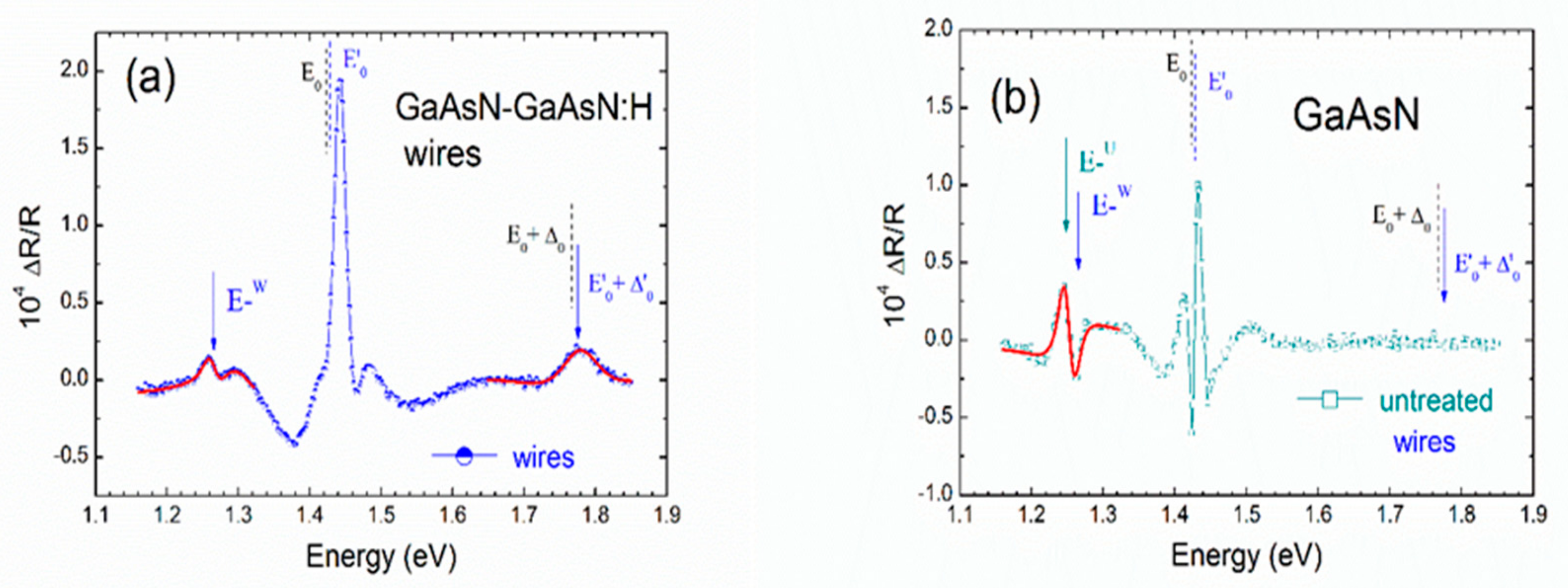
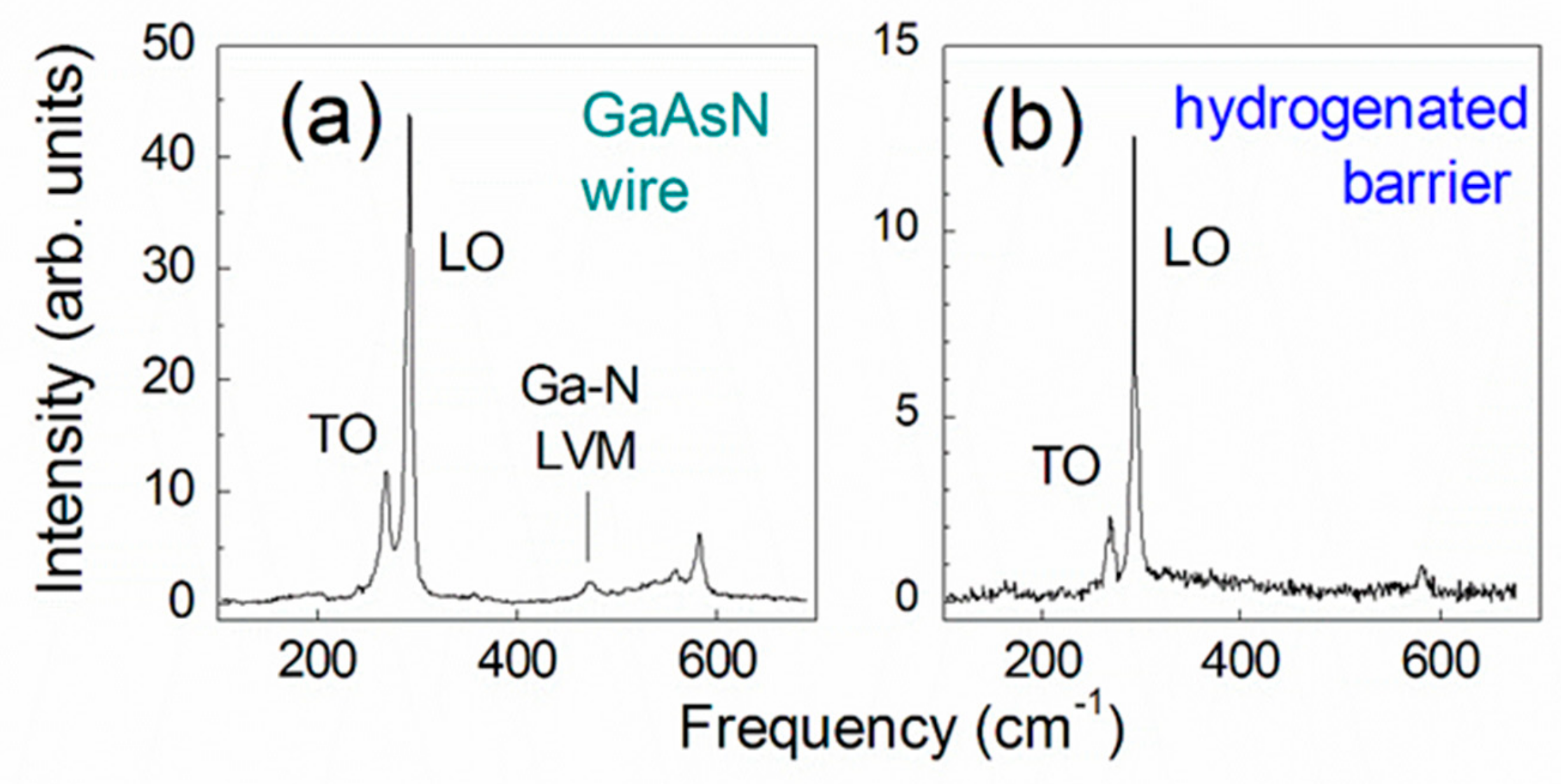
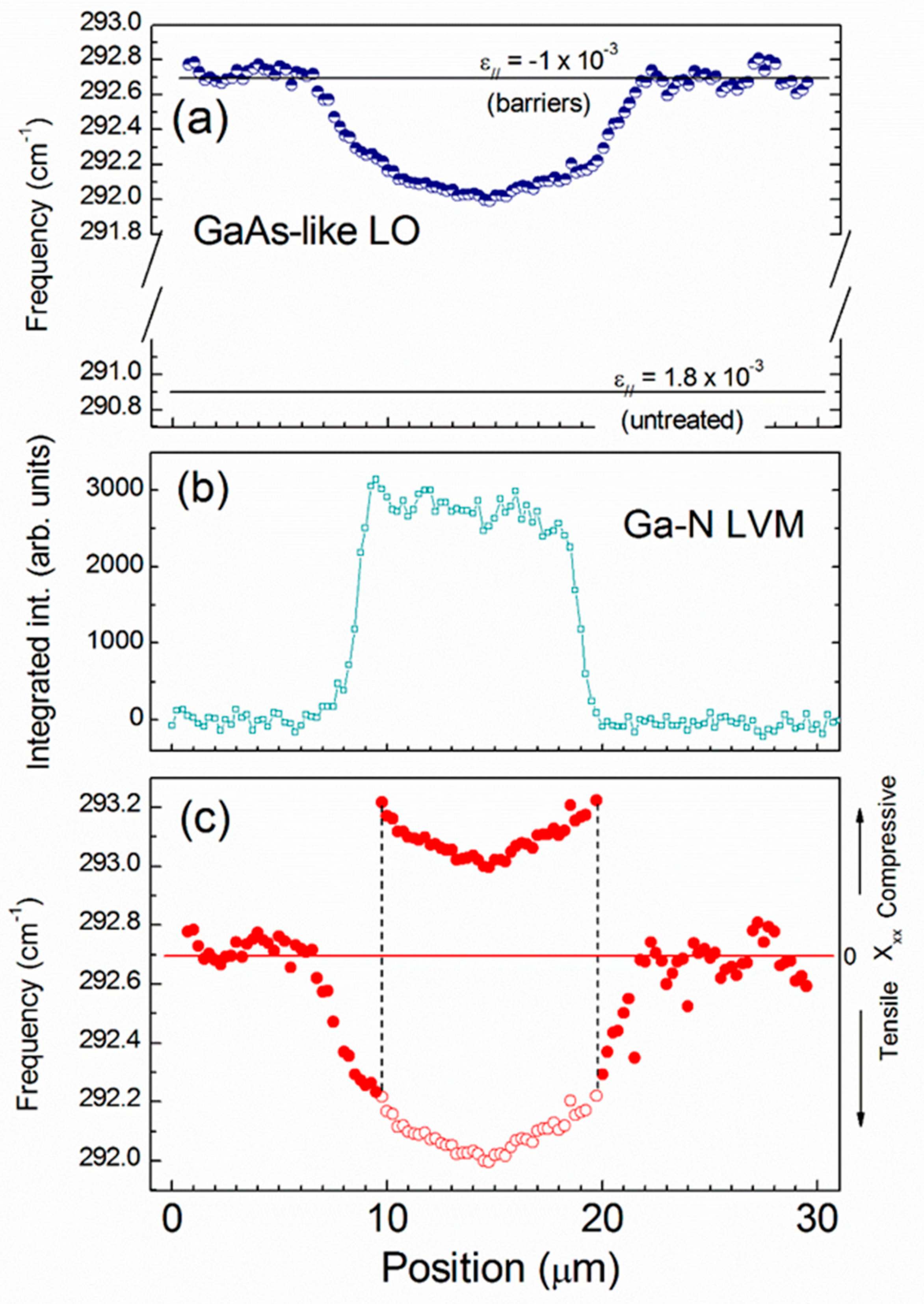
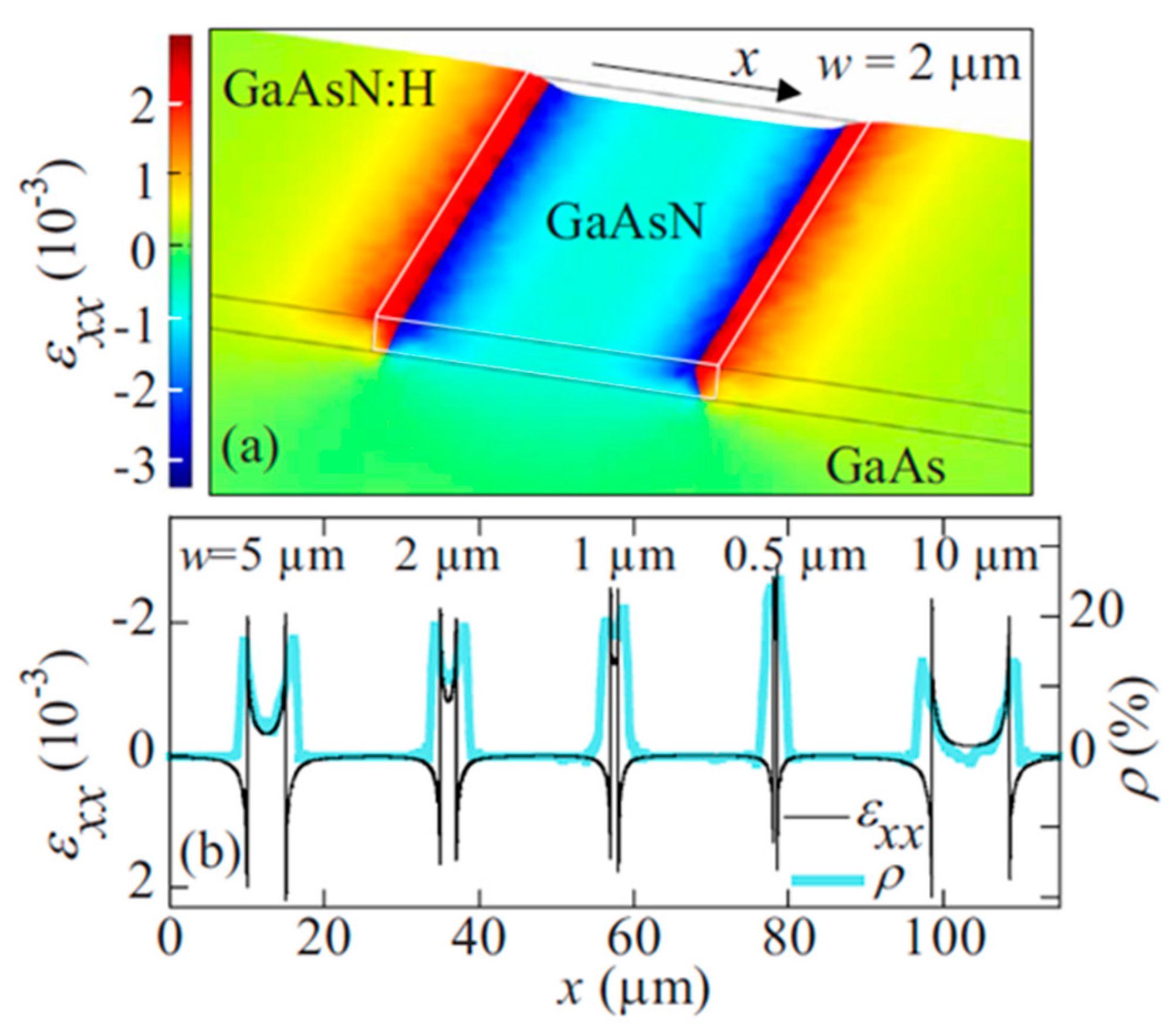
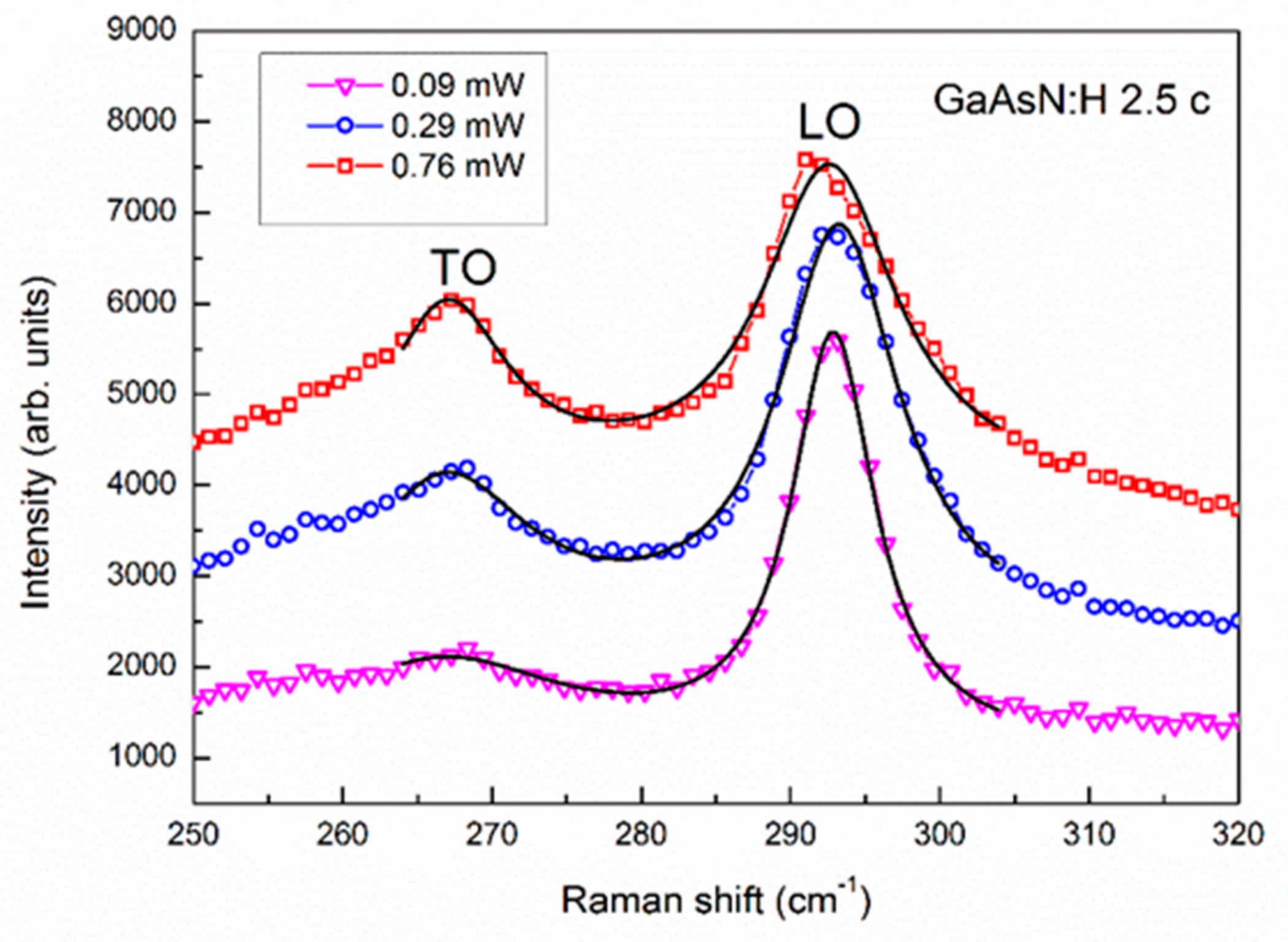
| Incident Light Polarization | Scattered Light Polarization | GaAs Reference | GaAsN | 1.2c H Dose | 2.5c H Dose | 3.5c H Dose |
|---|---|---|---|---|---|---|
| [110] | [110] (allowed) | 292.4 cm−1 | 291.6 cm−1 | 292.5 cm−1 | 292.8 cm−1 | 293.2 cm−1 |
| [110] | [1–10] (forbidden) | - | - | - | - | - |
| [100] | [010] (allowed) | 292.6 cm−1 | 292.2 cm−1 | 293.5 cm−1 | 293.9 cm−1 | 294.2 cm−1 |
| [100] | [100] (forbidden) | - | 290.4 cm−1 | 290.1 cm−1 | 289.6 cm−1 | 289.8 cm−1 |
© 2019 by the authors. Licensee MDPI, Basel, Switzerland. This article is an open access article distributed under the terms and conditions of the Creative Commons Attribution (CC BY) license (http://creativecommons.org/licenses/by/4.0/).
Share and Cite
Giulotto, E.; Geddo, M. Micro-Raman Mapping of the Strain Field in GaAsN/GaAsN:H Planar Heterostructures: A Brief Review and Recent Evolution. Appl. Sci. 2019, 9, 4864. https://doi.org/10.3390/app9224864
Giulotto E, Geddo M. Micro-Raman Mapping of the Strain Field in GaAsN/GaAsN:H Planar Heterostructures: A Brief Review and Recent Evolution. Applied Sciences. 2019; 9(22):4864. https://doi.org/10.3390/app9224864
Chicago/Turabian StyleGiulotto, Enrico, and Mario Geddo. 2019. "Micro-Raman Mapping of the Strain Field in GaAsN/GaAsN:H Planar Heterostructures: A Brief Review and Recent Evolution" Applied Sciences 9, no. 22: 4864. https://doi.org/10.3390/app9224864
APA StyleGiulotto, E., & Geddo, M. (2019). Micro-Raman Mapping of the Strain Field in GaAsN/GaAsN:H Planar Heterostructures: A Brief Review and Recent Evolution. Applied Sciences, 9(22), 4864. https://doi.org/10.3390/app9224864





